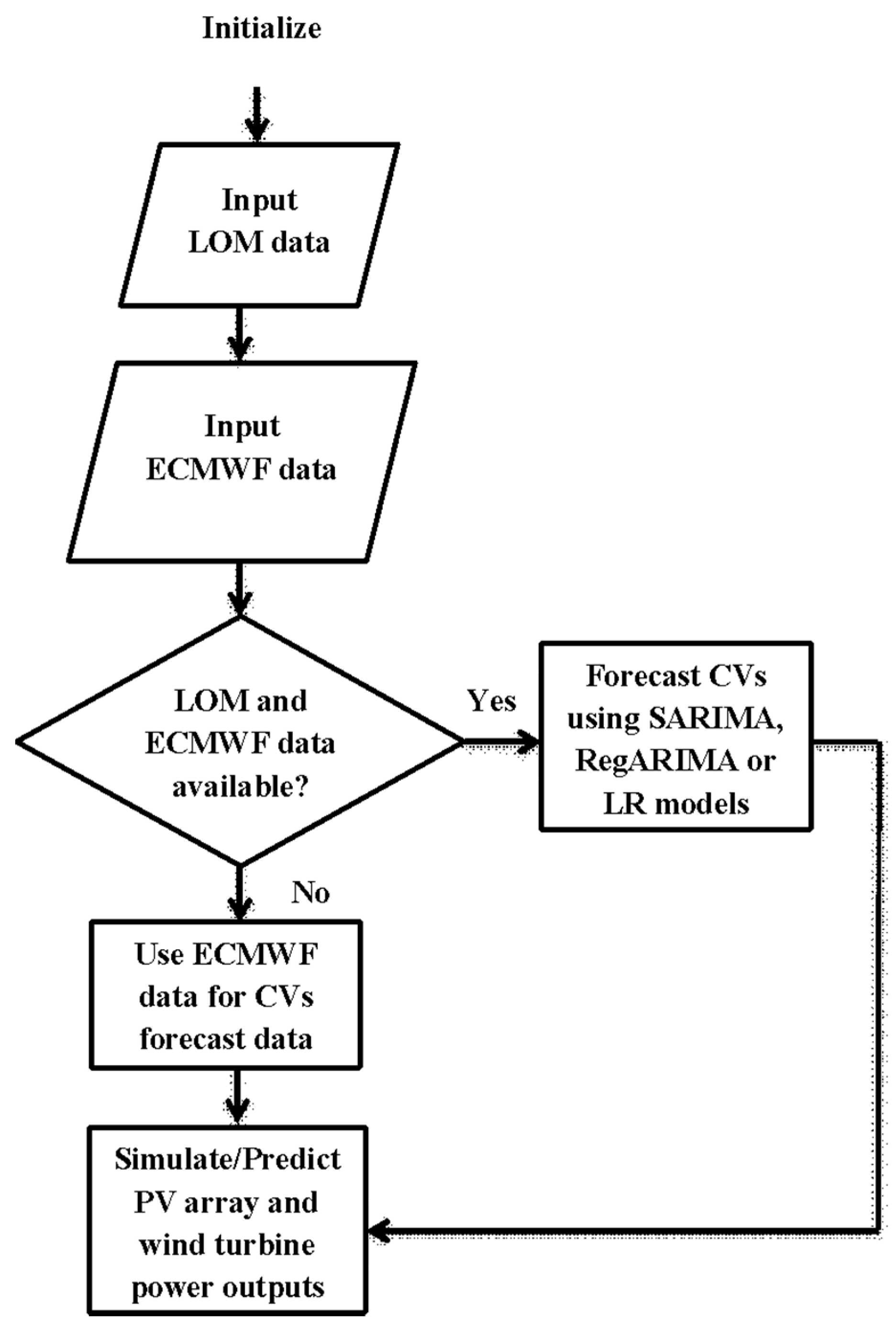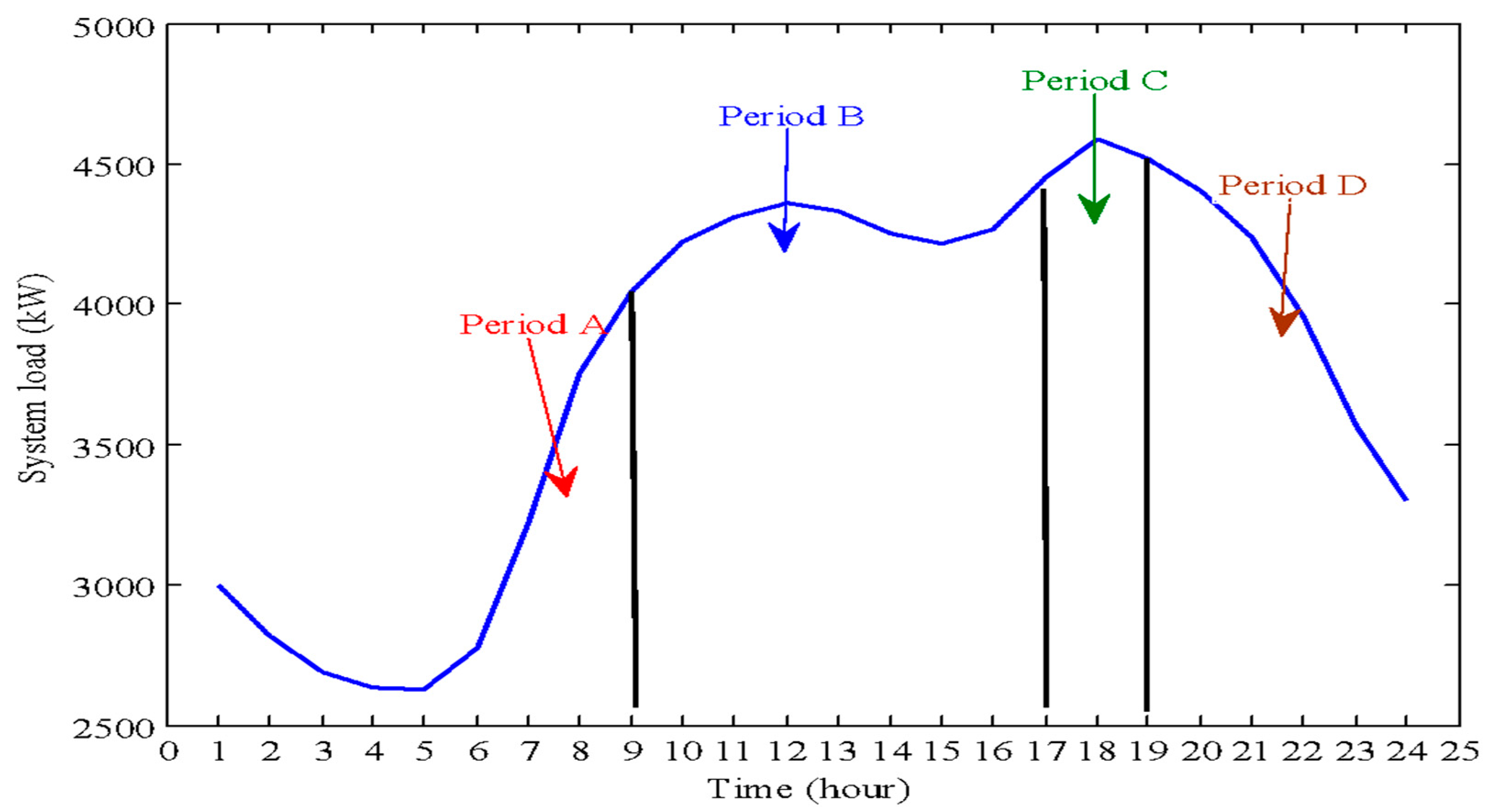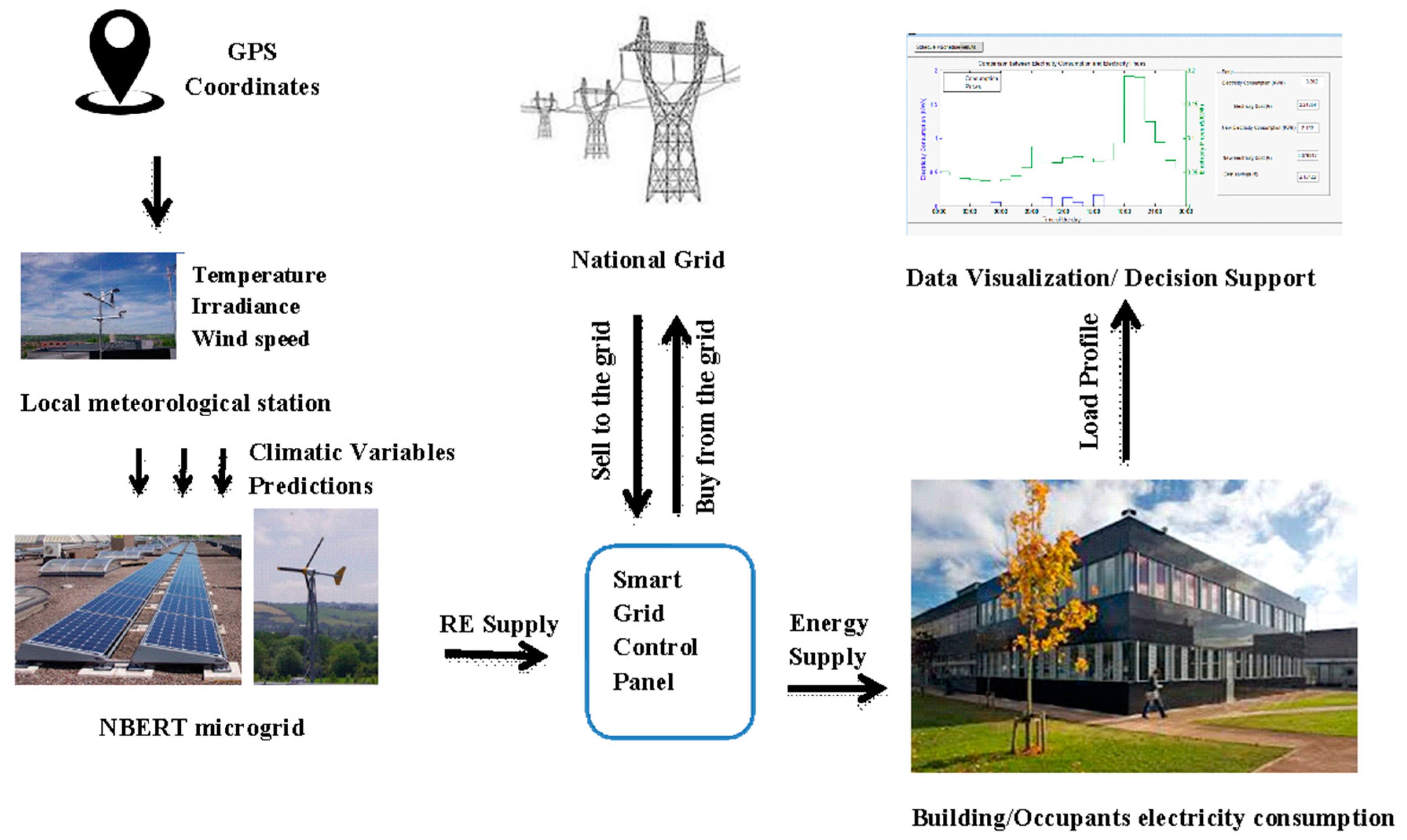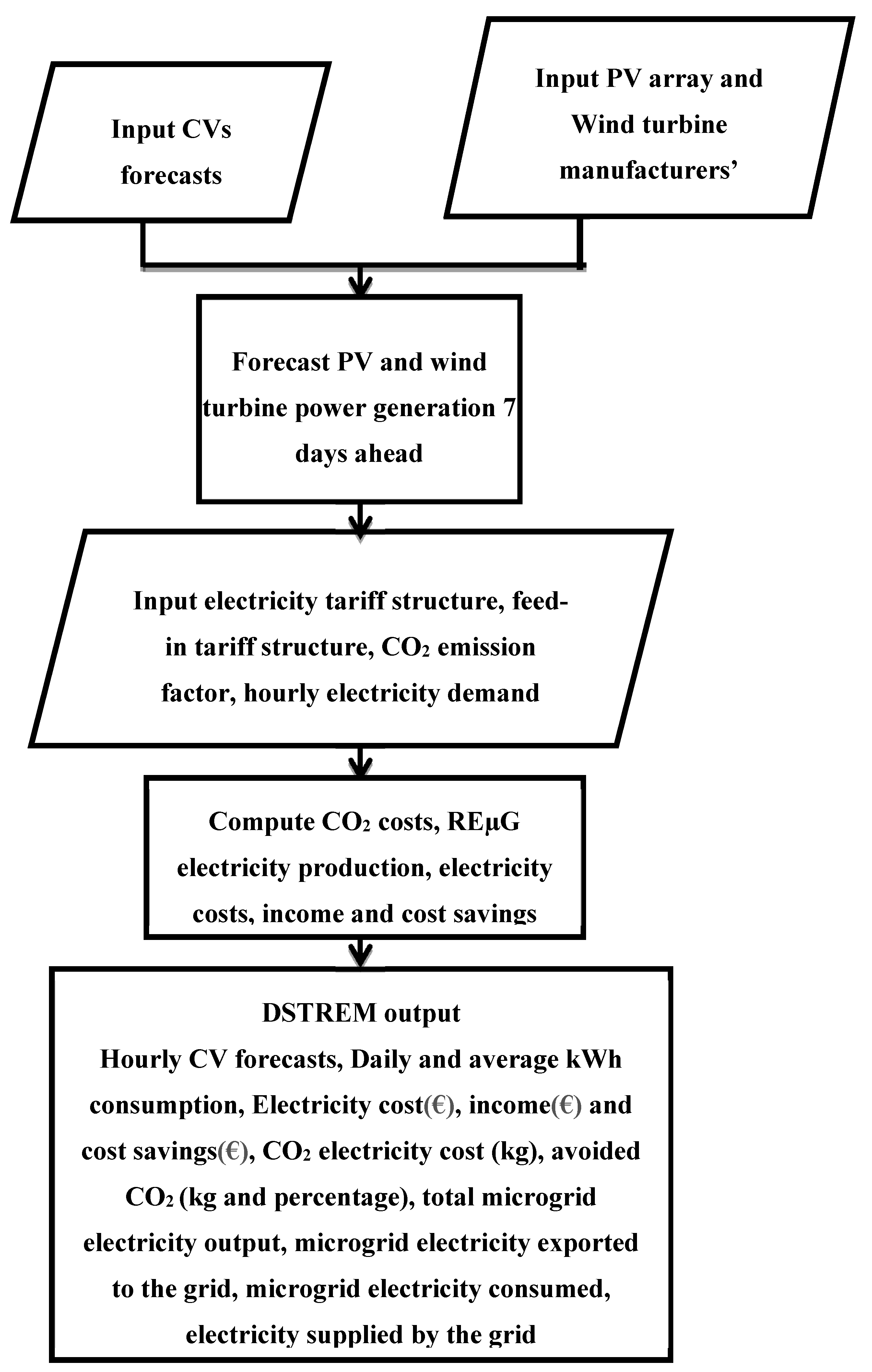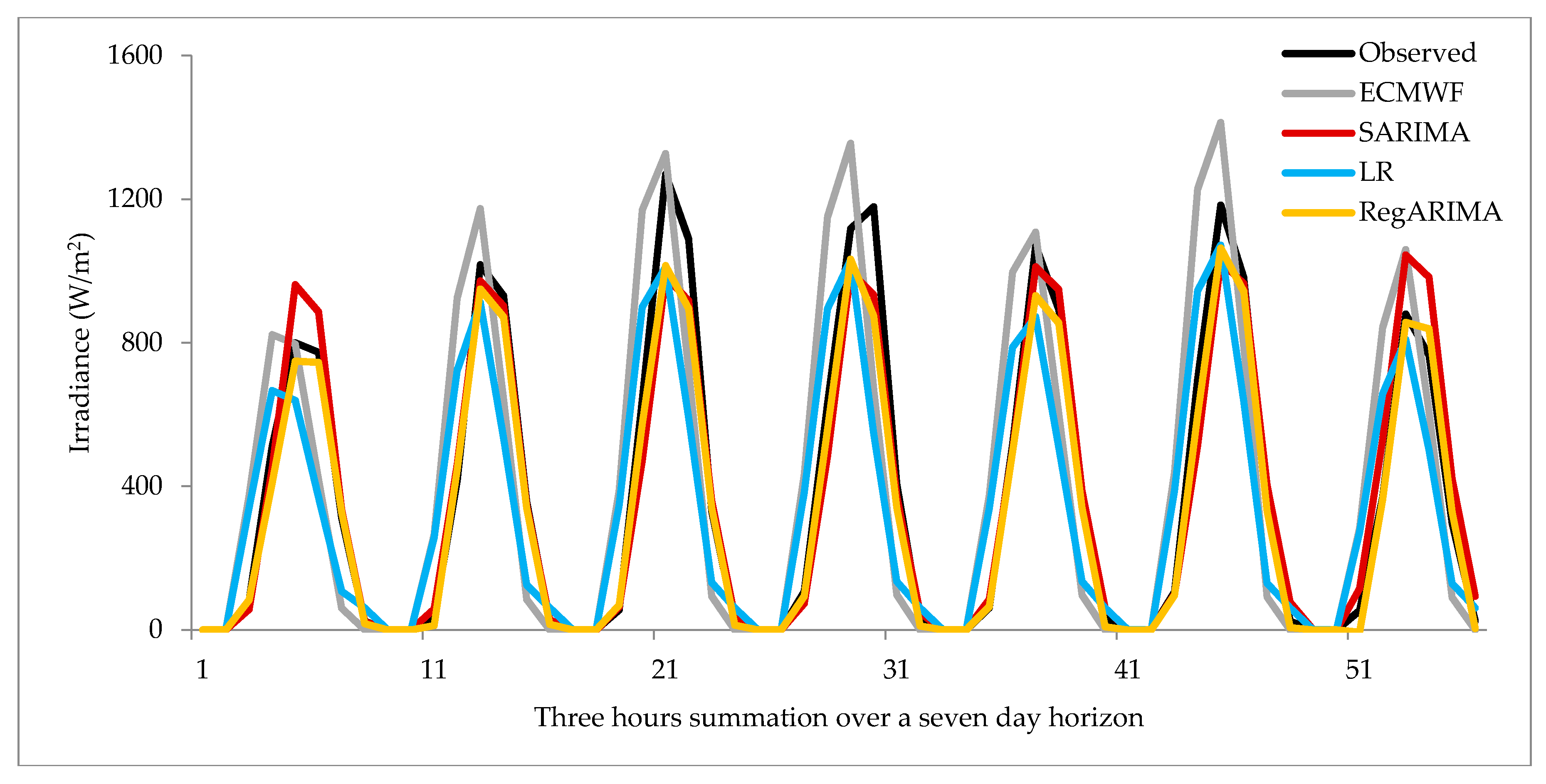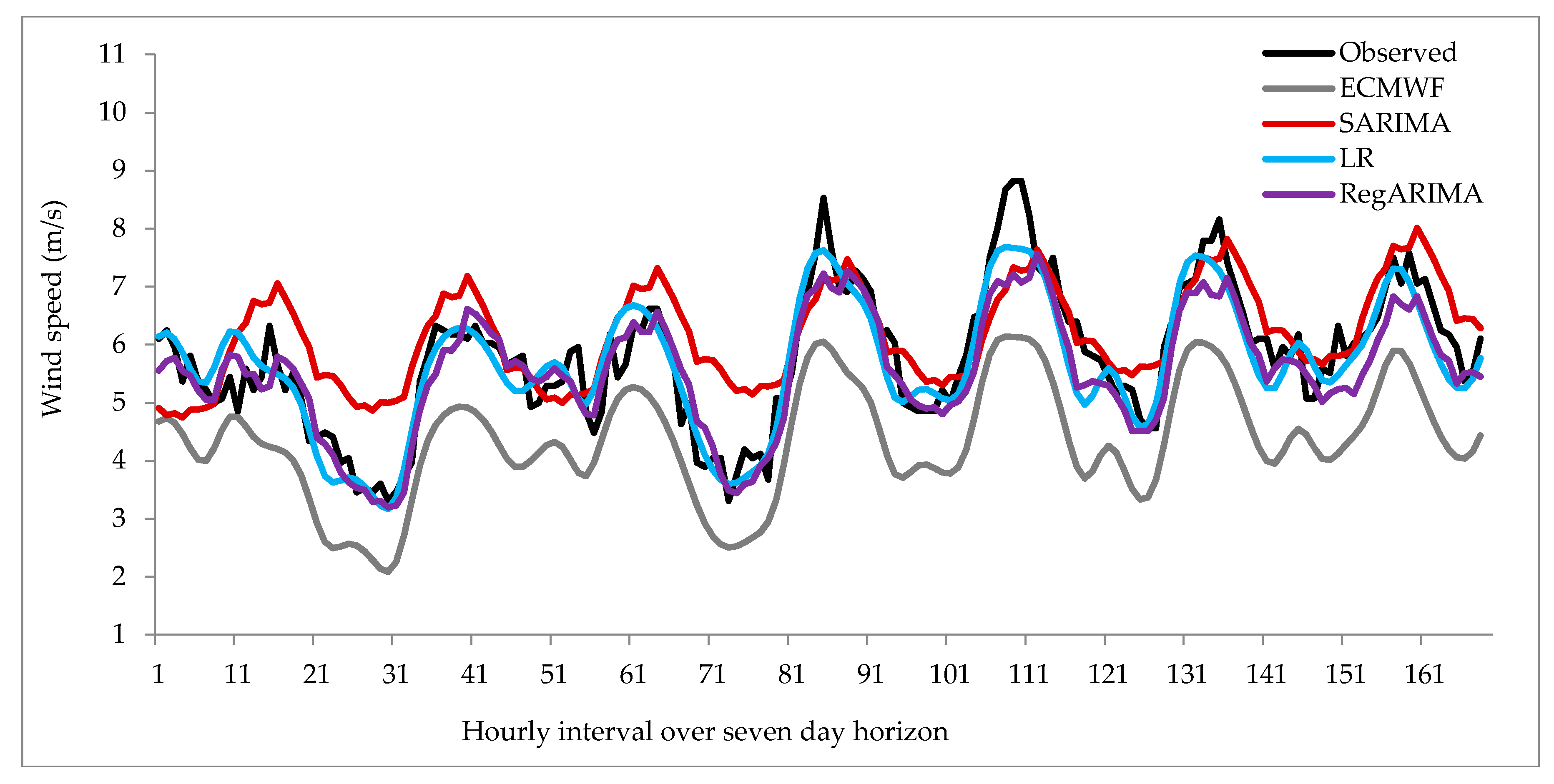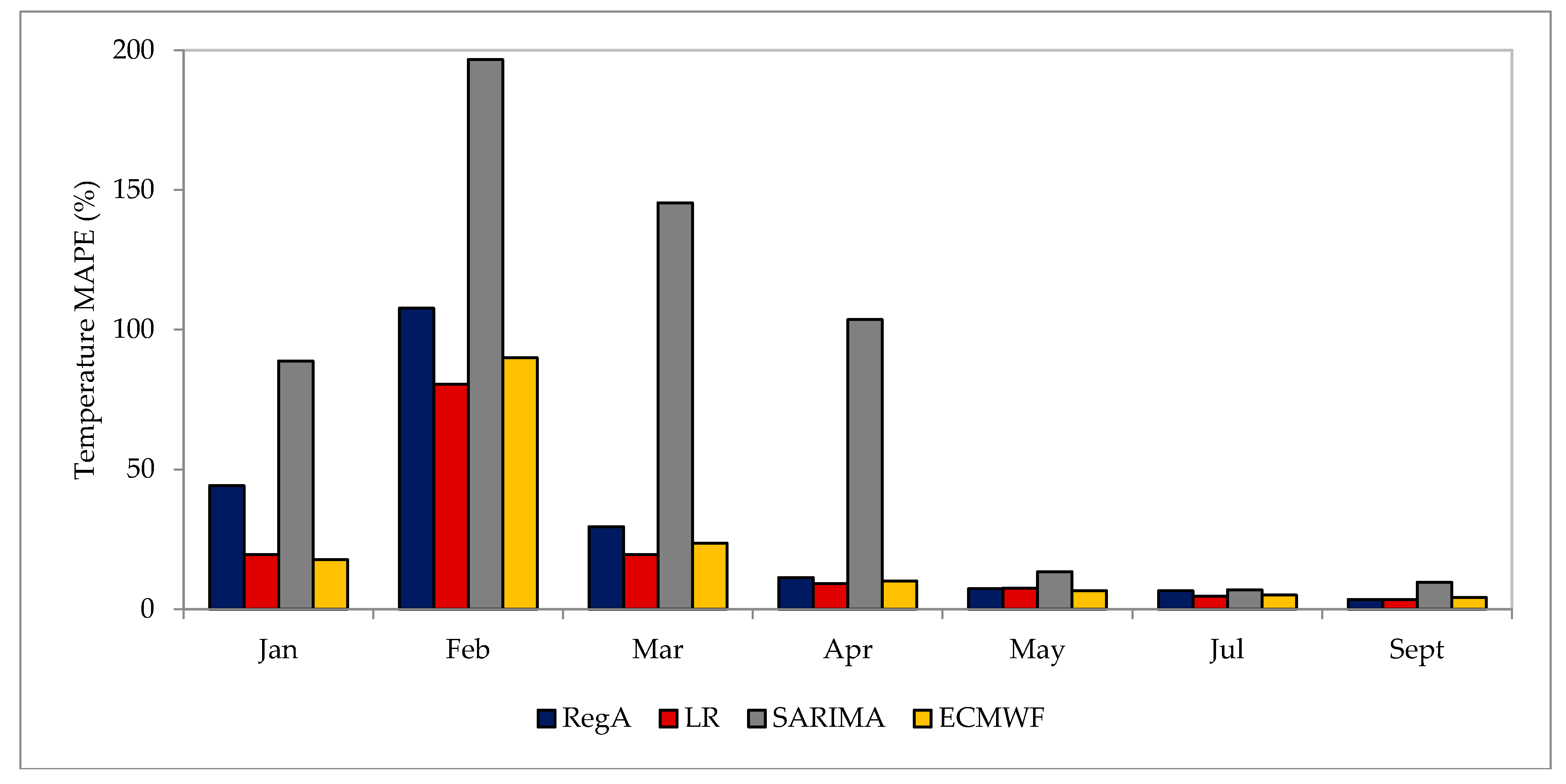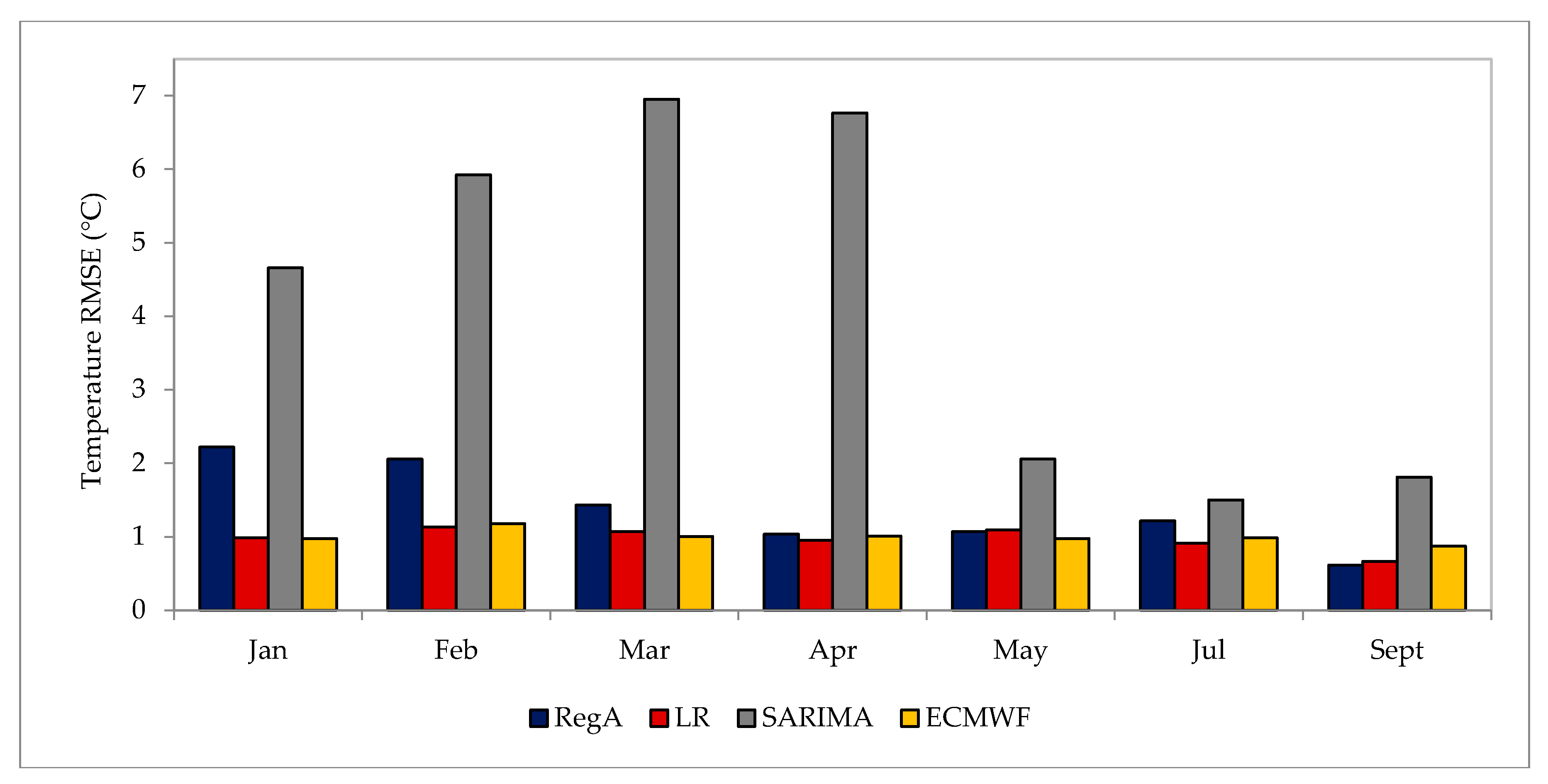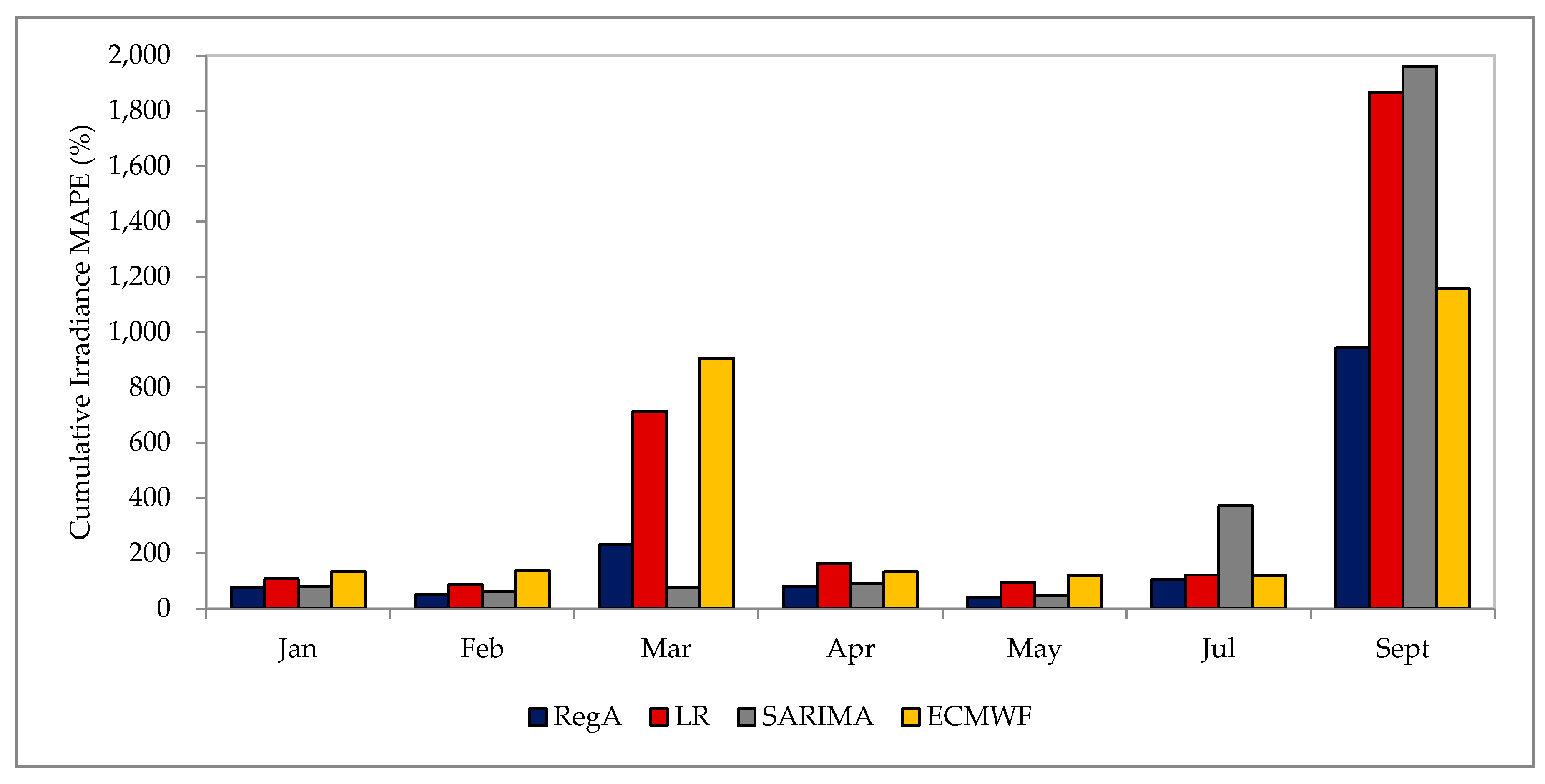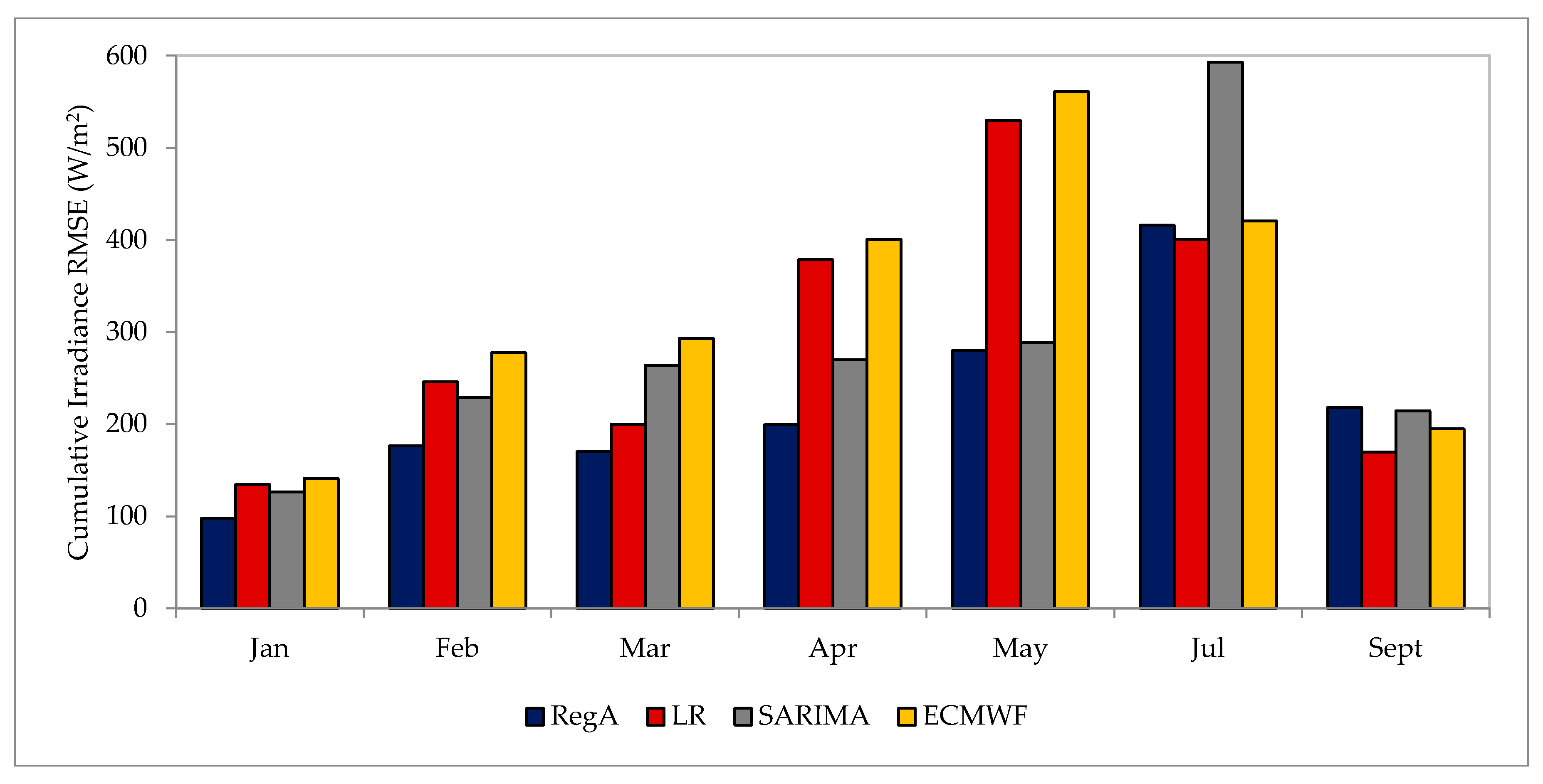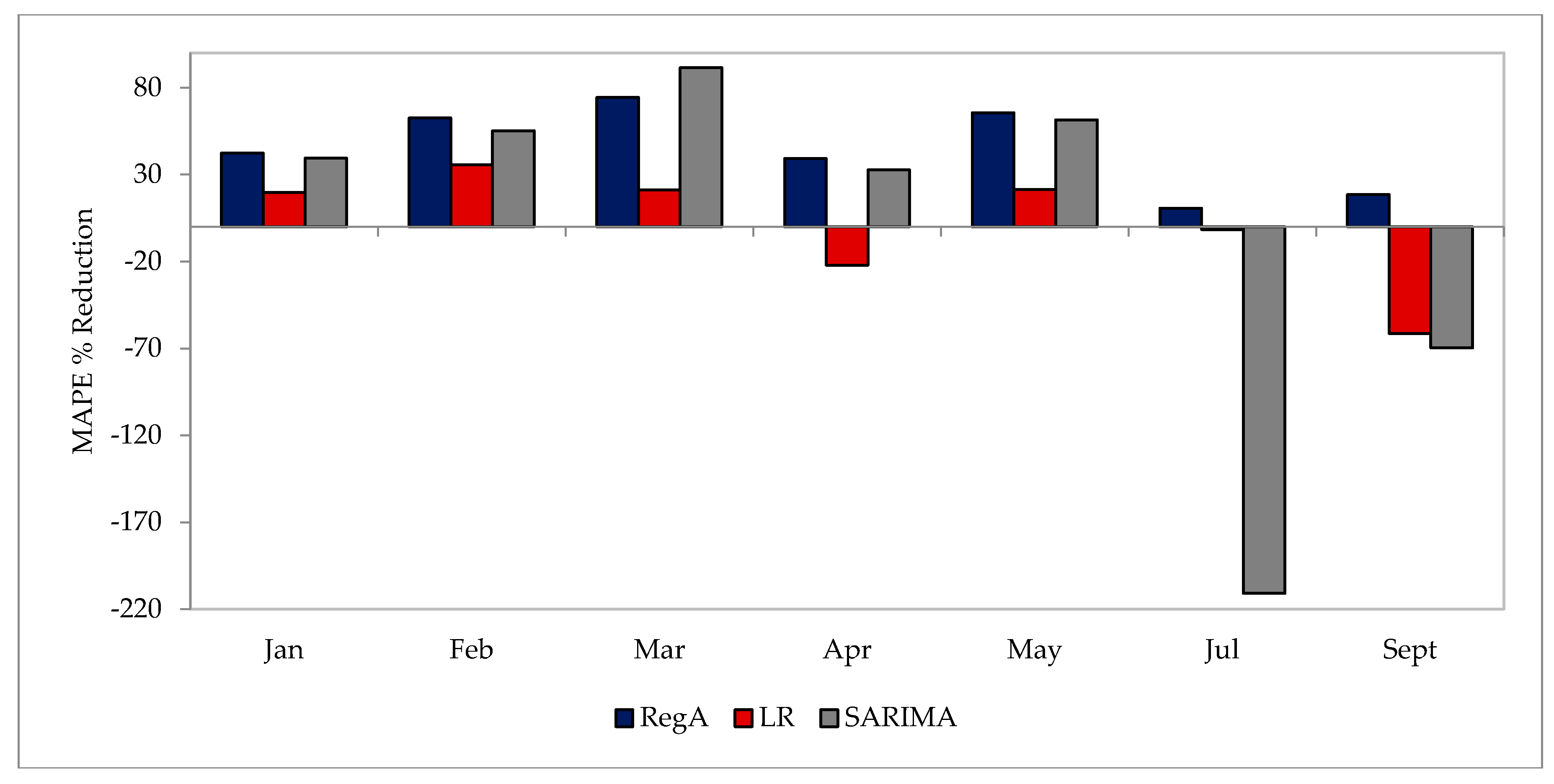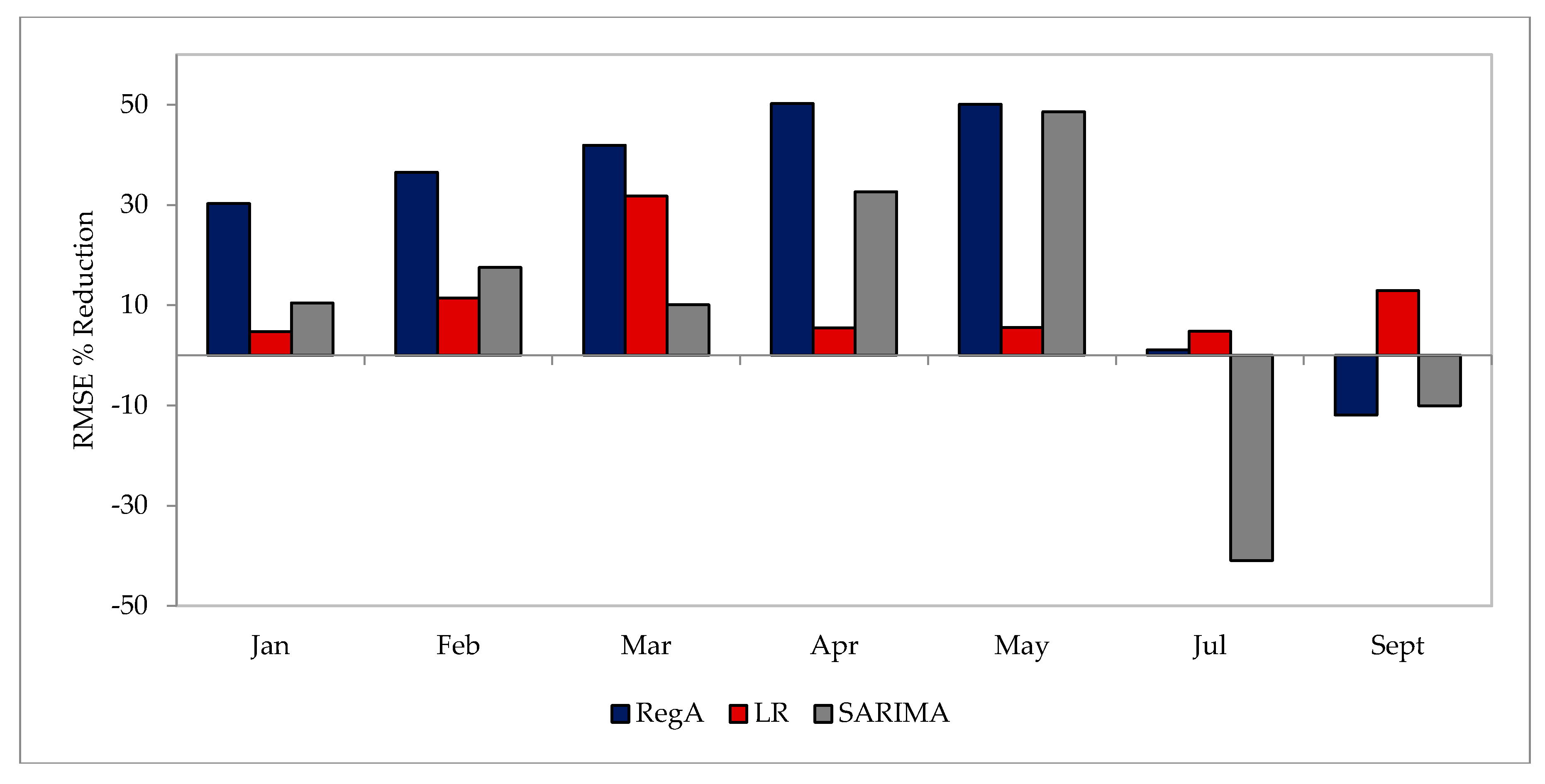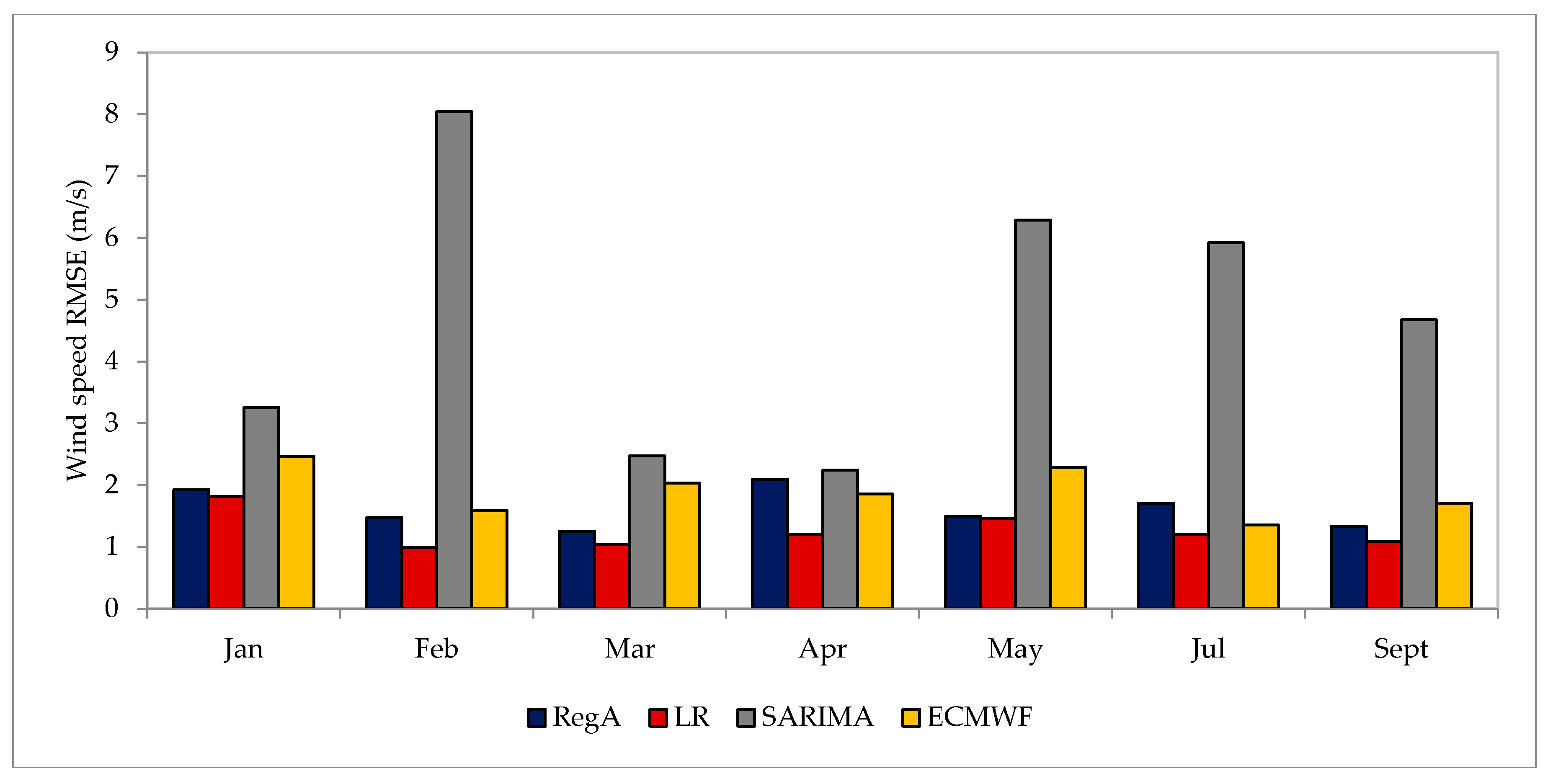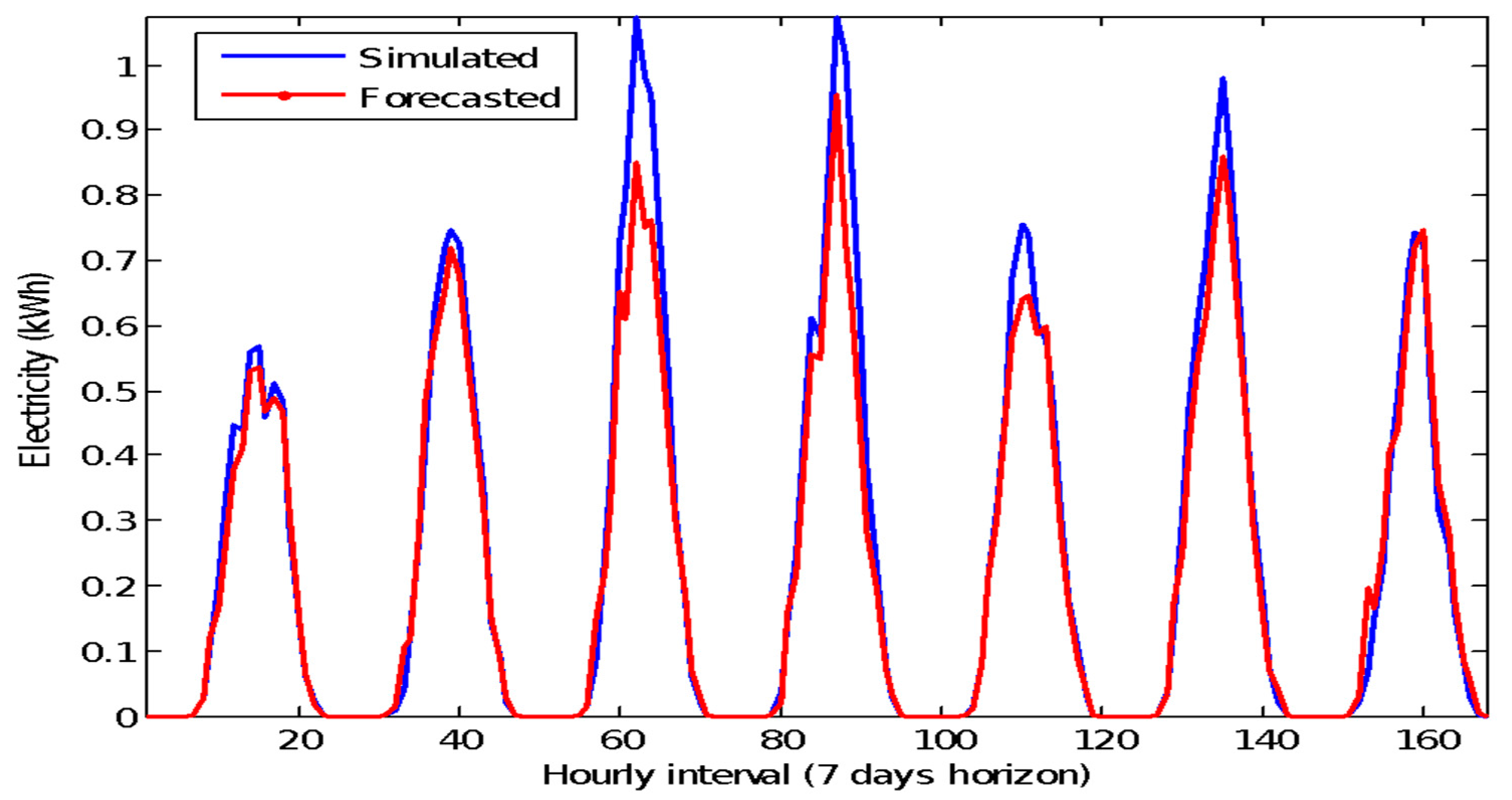Figure 1.
Climate variable input choice flow chart.
Figure 1.
Climate variable input choice flow chart.
Figure 2.
Sectionalized hourly average system load demand profile for 2013.
Figure 2.
Sectionalized hourly average system load demand profile for 2013.
Figure 3.
DSTREM system overview.
Figure 3.
DSTREM system overview.
Figure 4.
DSTREM process flow chart.
Figure 4.
DSTREM process flow chart.
Figure 5.
Predicted and observed temperature.
Figure 5.
Predicted and observed temperature.
Figure 6.
Predicted and observed irradiance.
Figure 6.
Predicted and observed irradiance.
Figure 7.
Predicted and observed wind speed.
Figure 7.
Predicted and observed wind speed.
Figure 8.
Temperature MAPE for all forecasting models and ECMWF data (RegA denotes RegARIMA model).
Figure 8.
Temperature MAPE for all forecasting models and ECMWF data (RegA denotes RegARIMA model).
Figure 9.
Temperature RMSE for all forecasting models and ECMWF data (RegA denotes RegARIMA model).
Figure 9.
Temperature RMSE for all forecasting models and ECMWF data (RegA denotes RegARIMA model).
Figure 10.
Percentage reduction of temperature MAPE relative to ECMWF data for all forecasting models (RegA denotes RegARIMA model).
Figure 10.
Percentage reduction of temperature MAPE relative to ECMWF data for all forecasting models (RegA denotes RegARIMA model).
Figure 11.
Percentage reduction of temperature RMSE relative to ECMWF data for all forecasting models (RegA denotes RegARIMA model).
Figure 11.
Percentage reduction of temperature RMSE relative to ECMWF data for all forecasting models (RegA denotes RegARIMA model).
Figure 12.
Cumulative irradiance MAPE for all forecasting models and ECMWF data (RegA denotes RegARIMA model).
Figure 12.
Cumulative irradiance MAPE for all forecasting models and ECMWF data (RegA denotes RegARIMA model).
Figure 13.
Cumulative irradiance RMSE for all forecasting models and ECMWF data (RegA denotes RegARIMA model).
Figure 13.
Cumulative irradiance RMSE for all forecasting models and ECMWF data (RegA denotes RegARIMA model).
Figure 14.
Percentage reduction of cumulative irradiance MAPE relative to ECMWF data for all forecasting models (RegA denotes RegARIMA model).
Figure 14.
Percentage reduction of cumulative irradiance MAPE relative to ECMWF data for all forecasting models (RegA denotes RegARIMA model).
Figure 15.
Percentage reduction of cumulative irradiance RMSE relative to ECMWF data for all forecasting models (RegA denotes RegARIMA model).
Figure 15.
Percentage reduction of cumulative irradiance RMSE relative to ECMWF data for all forecasting models (RegA denotes RegARIMA model).
Figure 16.
Wind speed MAPE for all forecasting models and ECMWF data (RegA denotes RegARIMA model).
Figure 16.
Wind speed MAPE for all forecasting models and ECMWF data (RegA denotes RegARIMA model).
Figure 17.
Wind speed RMSE for all forecasting models and ECMWF data (RegA denotes RegARIMA model).
Figure 17.
Wind speed RMSE for all forecasting models and ECMWF data (RegA denotes RegARIMA model).
Figure 18.
Percentage reduction of wind speed MAPE relative to ECMWF data for all forecasting models (RegA denotes RegARIMA model).
Figure 18.
Percentage reduction of wind speed MAPE relative to ECMWF data for all forecasting models (RegA denotes RegARIMA model).
Figure 19.
Percentage reduction of wind speed RMSE relative to ECMWF data for all forecasting models (RegA denotes RegARIMA model).
Figure 19.
Percentage reduction of wind speed RMSE relative to ECMWF data for all forecasting models (RegA denotes RegARIMA model).
Figure 20.
Simulated (using empirical data) and forecasted (using forecasted data) PV array power output (kWh).
Figure 20.
Simulated (using empirical data) and forecasted (using forecasted data) PV array power output (kWh).
Figure 21.
Simulated (using empirical data) and forecasted (using forecasted data) wind turbine power output (kWh).
Figure 21.
Simulated (using empirical data) and forecasted (using forecasted data) wind turbine power output (kWh).
Figure 22.
Hourly PV array, wind turbine and PV+Wind turbine power output predictions with corresponding hourly electricity demand totaled across the demonstration week.
Figure 22.
Hourly PV array, wind turbine and PV+Wind turbine power output predictions with corresponding hourly electricity demand totaled across the demonstration week.
Table 1.
FIT1 and FIT2 tariff margins for the system demand periods. Percentages shown represent the percentage of the buying price of electricity used to calculate the FIT in each period A to D.
Table 1.
FIT1 and FIT2 tariff margins for the system demand periods. Percentages shown represent the percentage of the buying price of electricity used to calculate the FIT in each period A to D.
| FIT | Period A | Period B | Period C | Period D |
|---|
| FIT1 | 90% | 100% | 110% | 100% |
| FIT2 | 30% | 130% | 200% | 40% |
Table 2.
Average RMSE for climatic variable predictions for the year 2013.
Table 2.
Average RMSE for climatic variable predictions for the year 2013.
| Climatic Variable | ECMWF | LR | SARIMA | RegARIMA |
|---|
| Temperature (°C) | 1.00 | 0.97 | 4.24 | 1.38 |
| Irradiance (W/m2) | 326.9 | 294.1 | 283.4 | 222.6 |
| Wind Speed (m/s) | 1.90 | 1.26 | 4.70 | 1.61 |
Table 3.
Average MWE (%) and average MAPE (%) for climatic variable predictions for the year 2013.
Table 3.
Average MWE (%) and average MAPE (%) for climatic variable predictions for the year 2013.
| Climatic Variable | MWE (%) | MAPE (%) |
|---|
| ECMWF | LR | SARIMA | RegARIMA | ECMWF | LR | SARIMA | RegARIMA |
|---|
| Temperature | 9 | 10 | −47 | −15 | 23 | 21 | 81 | 30 |
| Irradiance | 20 | −1 | −3 | 0 | 387 | 452 | 385 | 219 |
| Wind Speed | −117 | −4 | 51 | −21 | 28 | 22 | 97 | 28 |
Table 4.
Average percentage reduction of RMSE and MAPE by LR, SARIMA and RegARIMA relative to ECMWF forecasts.
Table 4.
Average percentage reduction of RMSE and MAPE by LR, SARIMA and RegARIMA relative to ECMWF forecasts.
| Climatic Variable | RMSE (%) | MAPE (%) |
|---|
| LR | SARIMA | RegARIMA | LR | SARIMA | RegARIMA |
|---|
| Temperature | 3 | −316 | −36 | 6 | −318 | −32 |
| Irradiance | 11 | 10 | 28 | 2 | −0.01 | 44 |
| Wind Speed | 33 | −167 | 12 | 20 | −234 | −0.21 |
Table 5.
Electricity exported (kWh and %), Electricity supplied by REμG (kWh and %), electricity supplied by national smart grid (kWh), percentage RE exported, percentage RE used, avoided CO2 by RE (kg and %) for the three REμG scenarios and for each day of the demonstration week.
Table 5.
Electricity exported (kWh and %), Electricity supplied by REμG (kWh and %), electricity supplied by national smart grid (kWh), percentage RE exported, percentage RE used, avoided CO2 by RE (kg and %) for the three REμG scenarios and for each day of the demonstration week.
| Day | REµG Scenario | Electricity Export (kWh) | Electricity REμG (kWh) | Electricity Grid (kWh) | % ex | % Used | % μG | % G | Avoided CO2 by RE (kg) | % Avoided CO2 |
|---|
| Friday | PV | 0.01 | 1.73 | 3.45 | 0 | 100 | 33 | 67 | 0.73 | 33 |
| Wind | 6.86 | 4.65 | 0.53 | 60 | 40 | 90 | 10 | 2.03 | 90 |
| PV+Wind | 8.12 | 5.13 | 0.05 | 61 | 39 | 99 | 1 | 2.23 | 99 |
| Saturday | PV | 2.91 | 0.00 | 0.00 | 100 | 0 | NA | NA | NA | NA |
| Wind | 0.16 | 0.00 | 0.00 | 100 | 0 | NA | NA | NA | NA |
| PV+Wind | 3.07 | 0.00 | 0.00 | 100 | 0 | NA | NA | NA | NA |
| Sunday | PV | 3.17 | 0.00 | 0.00 | 100 | 0 | NA | NA | NA | NA |
| Wind | 0.11 | 0.00 | 0.00 | 100 | 0 | NA | NA | NA | NA |
| PV+Wind | 3.28 | 0.00 | 0.00 | 100 | 0 | NA | NA | NA | NA |
| Monday | PV | 0.21 | 3.55 | 2.38 | 6 | 94 | 60 | 40 | 1.52 | 59 |
| Wind | 0.14 | 0.45 | 5.47 | 23 | 77 | 8 | 92 | 0.20 | 8 |
| PV+Wind | 0.56 | 3.79 | 2.13 | 13 | 87 | 64 | 36 | 1.63 | 63 |
| Tuesday | PV | 0.00 | 2.38 | 3.62 | 0 | 100 | 40 | 60 | 1.02 | 39 |
| Wind | 0.11 | 1.00 | 5.00 | 10 | 90 | 17 | 83 | 0.43 | 16 |
| PV+Wind | 0.31 | 3.18 | 2.82 | 9 | 91 | 53 | 47 | 1.37 | 52 |
| Wednesday | PV | 0.02 | 1.99 | 2.68 | 1 | 99 | 43 | 57 | 0.85 | 42 |
| Wind | 0.12 | 0.58 | 4.09 | 17 | 83 | 12 | 88 | 0.25 | 12 |
| PV+Wind | 0.28 | 2.42 | 2.25 | 10 | 90 | 52 | 48 | 1.04 | 51 |
| Thursday | PV | 0.24 | 3.28 | 2.51 | 7 | 93 | 57 | 43 | 1.40 | 56 |
| Wind | 0.49 | 1.16 | 4.63 | 30 | 70 | 20 | 80 | 0.51 | 20 |
| PV+Wind | 0.89 | 4.27 | 1.51 | 17 | 83 | 74 | 26 | 1.84 | 73 |
Table 6.
Electricity cost reduction (€ and %) generated by the REμG relative to buying all required electricity from the national smart grid across the three ET structures and the three REμG scenarios for each day of the demonstration week.
Table 6.
Electricity cost reduction (€ and %) generated by the REμG relative to buying all required electricity from the national smart grid across the three ET structures and the three REμG scenarios for each day of the demonstration week.
| Day | REµG Scenario | RTP (€) | TOU (€) | DN (€) | RTP (%) | TOU (%) | DN (%) |
|---|
| Friday | PV | 0.36 | 0.27 | 0.28 | 34 | 34 | 34 |
| Wind | 0.97 | 0.71 | 0.72 | 89 | 88 | 89 |
| PV+Wind | 1.07 | 0.79 | 0.79 | 99 | 99 | 99 |
| Saturday | PV | 0.00 | 0.00 | 0.00 | NA | NA | NA |
| Wind | 0.00 | 0.00 | 0.00 | NA | NA | NA |
| PV+Wind | 0.00 | 0.00 | 0.00 | NA | NA | NA |
| Sunday | PV | 0.00 | 0.00 | 0.00 | NA | NA | NA |
| Wind | 0.00 | 0.00 | 0.00 | NA | NA | NA |
| PV+Wind | 0.00 | 0.00 | 0.00 | NA | NA | NA |
| Monday | PV | 0.75 | 0.55 | 0.57 | 60 | 60 | 62 |
| Wind | 0.10 | 0.07 | 0.07 | 8 | 8 | 8 |
| PV+Wind | 0.80 | 0.58 | 0.61 | 64 | 64 | 66 |
| Tuesday | PV | 0.50 | 0.37 | 0.38 | 40 | 40 | 41 |
| Wind | 0.21 | 0.15 | 0.16 | 17 | 16 | 17 |
| PV+Wind | 0.67 | 0.49 | 0.51 | 53 | 53 | 54 |
| Wednesday | PV | 0.42 | 0.32 | 0.32 | 43 | 43 | 44 |
| Wind | 0.12 | 0.09 | 0.09 | 12 | 12 | 13 |
| PV+Wind | 0.51 | 0.38 | 0.39 | 52 | 52 | 53 |
| Thursday | PV | 0.69 | 0.50 | 0.52 | 57 | 56 | 58 |
| Wind | 0.24 | 0.17 | 0.18 | 20 | 20 | 20 |
| PV+Wind | 0.90 | 0.65 | 0.67 | 74 | 73 | 75 |
Table 7.
Daily income (€) and cost savings (€) for three microgrid electricity supply options (PV, Wind, and PV+Wind), under three ET structures (RTP, TOU and DN) for FIT1.
Table 7.
Daily income (€) and cost savings (€) for three microgrid electricity supply options (PV, Wind, and PV+Wind), under three ET structures (RTP, TOU and DN) for FIT1.
| Day | Income (€) | Savings (€) |
|---|
| RTP | PV | Wind | PV+Wind | PV | Wind | PV+Wind |
| Friday | 0.00 | 1.20 | 1.46 | 0.37 | 2.16 | 2.53 |
| Saturday | 0.62 | 0.03 | 0.65 | 0.62 | 0.03 | 0.65 |
| Sunday | 0.67 | 0.02 | 0.69 | 0.67 | 0.02 | 0.69 |
| Monday | 0.05 | 0.02 | 0.11 | 0.79 | 0.12 | 0.91 |
| Tuesday | 0.00 | 0.02 | 0.06 | 0.50 | 0.23 | 0.73 |
| Wednesday | 0.00 | 0.02 | 0.06 | 0.42 | 0.14 | 0.57 |
| Thursday | 0.05 | 0.10 | 0.18 | 0.74 | 0.34 | 1.08 |
| TOU | PV | Wind | PV+Wind | PV | Wind | PV+Wind |
| Friday | 0.00 | 0.89 | 1.09 | 0.27 | 1.60 | 1.88 |
| Saturday | 0.45 | 0.02 | 0.48 | 0.45 | 0.02 | 0.48 |
| Sunday | 0.49 | 0.01 | 0.50 | 0.49 | 0.01 | 0.50 |
| Monday | 0.03 | 0.02 | 0.08 | 0.58 | 0.09 | 0.67 |
| Tuesday | 0.00 | 0.02 | 0.04 | 0.37 | 0.17 | 0.54 |
| Wednesday | 0.00 | 0.02 | 0.04 | 0.32 | 0.10 | 0.42 |
| Thursday | 0.04 | 0.07 | 0.13 | 0.54 | 0.24 | 0.78 |
| DN | PV | Wind | PV+Wind | PV | Wind | PV+Wind |
| Friday | 0.00 | 0.60 | 0.80 | 0.28 | 1.32 | 1.60 |
| Saturday | 0.47 | 0.02 | 0.49 | 0.47 | 0.02 | 0.49 |
| Sunday | 0.51 | 0.01 | 0.52 | 0.51 | 0.01 | 0.52 |
| Monday | 0.03 | 0.01 | 0.08 | 0.60 | 0.08 | 0.69 |
| Tuesday | 0.00 | 0.01 | 0.04 | 0.38 | 0.17 | 0.55 |
| Wednesday | 0.00 | 0.02 | 0.04 | 0.32 | 0.11 | 0.43 |
| Thursday | 0.04 | 0.07 | 0.13 | 0.56 | 0.24 | 0.80 |
Table 8.
Daily income (€) and cost savings (€) for three microgrid electricity supply options (PV, Wind, and PV+Wind), under three ET structures (RTP, TOU and DN) for FIT2.
Table 8.
Daily income (€) and cost savings (€) for three microgrid electricity supply options (PV, Wind, and PV+Wind), under three ET structures (RTP, TOU and DN) for FIT2.
| Day | Income (€) | Savings(€) |
|---|
| RTP | PV | Wind | PV+Wind | PV | Wind | PV+Wind |
| Friday | 0.00 | 0.63 | 0.98 | 0.37 | 1.60 | 2.05 |
| Saturday | 0.83 | 0.02 | 0.84 | 0.83 | 0.02 | 0.84 |
| Sunday | 0.88 | 0.01 | 0.89 | 0.88 | 0.01 | 0.89 |
| Monday | 0.06 | 0.01 | 0.13 | 0.81 | 0.10 | 0.93 |
| Tuesday | 0.00 | 0.01 | 0.06 | 0.50 | 0.22 | 0.73 |
| Wednesday | 0.00 | 0.01 | 0.05 | 0.42 | 0.13 | 0.56 |
| Thursday | 0.07 | 0.04 | 0.15 | 0.76 | 0.28 | 1.04 |
| TOU | PV | Wind | PV+Wind | PV | Wind | PV+Wind |
| Friday | 0.00 | 0.46 | 0.71 | 0.27 | 1.17 | 1.50 |
| Saturday | 0.61 | 0.01 | 0.63 | 0.61 | 0.01 | 0.63 |
| Sunday | 0.65 | 0.01 | 0.65 | 0.65 | 0.01 | 0.65 |
| Monday | 0.05 | 0.01 | 0.09 | 0.59 | 0.07 | 0.68 |
| Tuesday | 0.00 | 0.01 | 0.04 | 0.37 | 0.16 | 0.53 |
| Wednesday | 0.00 | 0.01 | 0.04 | 0.32 | 0.09 | 0.42 |
| Thursday | 0.05 | 0.03 | 0.11 | 0.55 | 0.20 | 0.76 |
| DN | PV | Wind | PV+Wind | PV | Wind | PV+Wind |
| Friday | 0.00 | 0.37 | 0.64 | 0.28 | 1.09 | 1.43 |
| Saturday | 0.63 | 0.01 | 0.64 | 0.63 | 0.01 | 0.64 |
| Sunday | 0.67 | 0.01 | 0.68 | 0.67 | 0.01 | 0.68 |
| Monday | 0.05 | 0.00 | 0.09 | 0.61 | 0.08 | 0.70 |
| Tuesday | 0.00 | 0.00 | 0.04 | 0.38 | 0.16 | 0.55 |
| Wednesday | 0.00 | 0.01 | 0.04 | 0.32 | 0.10 | 0.42 |
| Thursday | 0.05 | 0.03 | 0.11 | 0.57 | 0.20 | 0.78 |
Table 9.
Daily income (€) and cost savings (€) for three microgrid electricity supply options (PV, Wind, and PV+Wind), under three ET structures (RTP, TOU and DN) for FIT3.
Table 9.
Daily income (€) and cost savings (€) for three microgrid electricity supply options (PV, Wind, and PV+Wind), under three ET structures (RTP, TOU and DN) for FIT3.
| Day | Income (€) | Savings (€) |
|---|
| RTP | PV | Wind | PV+Wind | PV | Wind | PV+Wind |
| Friday | 0.00 | 0.62 | 0.73 | 0.37 | 1.59 | 1.80 |
| Saturday | 0.26 | 0.01 | 0.28 | 0.26 | 0.01 | 0.28 |
| Sunday | 0.29 | 0.01 | 0.30 | 0.29 | 0.01 | 0.30 |
| Monday | 0.02 | 0.01 | 0.05 | 0.77 | 0.11 | 0.85 |
| Tuesday | 0.00 | 0.01 | 0.03 | 0.50 | 0.22 | 0.70 |
| Wednesday | 0.00 | 0.01 | 0.03 | 0.42 | 0.13 | 0.54 |
| Thursday | 0.02 | 0.04 | 0.08 | 0.71 | 0.29 | 0.98 |
| TOU | PV | Wind | PV+Wind | PV | Wind | PV+Wind |
| Friday | 0.00 | 0.62 | 0.73 | 0.27 | 1.33 | 1.52 |
| Saturday | 0.26 | 0.01 | 0.28 | 0.26 | 0.01 | 0.28 |
| Sunday | 0.29 | 0.01 | 0.30 | 0.29 | 0.01 | 0.30 |
| Monday | 0.02 | 0.01 | 0.05 | 0.57 | 0.08 | 0.63 |
| Tuesday | 0.00 | 0.01 | 0.03 | 0.37 | 0.16 | 0.52 |
| Wednesday | 0.00 | 0.01 | 0.03 | 0.32 | 0.10 | 0.41 |
| Thursday | 0.02 | 0.04 | 0.08 | 0.52 | 0.22 | 0.73 |
| DN | PV | Wind | PV+Wind | PV | Wind | PV+Wind |
| Friday | 0.00 | 0.62 | 0.73 | 0.28 | 1.34 | 1.52 |
| Saturday | 0.26 | 0.01 | 0.28 | 0.26 | 0.01 | 0.28 |
| Sunday | 0.29 | 0.01 | 0.30 | 0.29 | 0.01 | 0.30 |
| Monday | 0.02 | 0.01 | 0.05 | 0.59 | 0.08 | 0.66 |
| Tuesday | 0.00 | 0.01 | 0.03 | 0.38 | 0.17 | 0.53 |
| Wednesday | 0.00 | 0.01 | 0.03 | 0.32 | 0.10 | 0.41 |
| Thursday | 0.02 | 0.04 | 0.08 | 0.54 | 0.22 | 0.76 |
